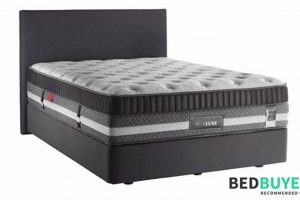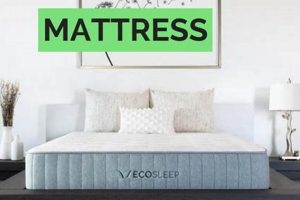A mattress featuring a distinct upper layer, integrated or sewn on, designed to enhance cushioning and softness, constitutes a pillow top. When tailored for individuals who primarily sleep on their sides, this design aims to alleviate pressure points concentrated at the shoulders and hips. This specific type of mattress prioritizes comfort and spinal alignment for those favoring a lateral sleeping position.
Selecting a mattress optimized for side sleeping is crucial for promoting proper spinal health and minimizing discomfort. By conforming to the body’s contours, it reduces strain on joints and promotes deeper, more restorative sleep. Historically, individuals sought makeshift solutions for added comfort; modern iterations offer sophisticated designs and materials to optimize the sleep experience and address specific postural needs.
The subsequent sections will explore key considerations for selecting an appropriate mattress, including material composition, firmness levels, and specific features to support optimal sleep quality for side sleepers. Further, we will examine common misconceptions and provide practical advice to facilitate informed decision-making.
Guidance on Pillow Top Mattresses for Lateral Sleepers
The following guidelines provide key considerations when selecting a mattress designed to enhance comfort and support for those who primarily sleep on their side. These recommendations aim to promote optimal spinal alignment and reduce pressure point discomfort.
Tip 1: Prioritize Pressure Relief. A mattress intended for side sleepers must effectively alleviate pressure on the shoulders and hips. Materials such as memory foam or latex, combined with a plush pillow top, can distribute weight and minimize discomfort in these areas.
Tip 2: Evaluate Firmness Levels. While personal preference is a factor, a medium to medium-soft firmness generally proves suitable for side sleepers. This level of support allows the spine to maintain its natural curvature, preventing excessive sinking or inadequate support.
Tip 3: Consider Material Composition. The core materials within the mattress contribute significantly to its overall performance. High-density foams or innerspring systems provide a stable foundation, while the pillow top should incorporate responsive materials that contour to the body.
Tip 4: Examine Edge Support. Robust edge support is particularly beneficial for couples or individuals who utilize the full surface of the mattress. Reinforced edges prevent sagging and ensure consistent support across the entire sleeping area.
Tip 5: Assess Spinal Alignment. Proper spinal alignment is paramount for preventing back pain and promoting restorative sleep. A suitable mattress should maintain the spine’s natural curvature when lying on the side, avoiding excessive bending or twisting.
Tip 6: Layer construction. A well-made mattress will have several layers of material. Springs or coils are the bottom support. A layer of foam above that to isolate motion from the springs. Finally, the pillow top layer for comfort and breathability.
Adhering to these recommendations can significantly improve sleep quality and minimize musculoskeletal discomfort associated with lateral sleeping positions. Choosing a mattress that effectively addresses pressure relief, firmness, and spinal alignment is crucial for long-term well-being.
The concluding section will offer additional insights into common challenges and provide resources for further research and professional guidance.
1. Pressure Point Relief
Pressure point relief is a primary consideration in selecting a mattress, particularly for side sleepers. A mattress that effectively alleviates pressure promotes spinal alignment and reduces discomfort, ultimately contributing to a more restorative sleep experience. The design and materials directly influence this crucial aspect of sleep.
- Contouring and Conformity
The ability of a mattress to contour to the body’s natural curves is paramount for pressure relief. Materials like memory foam and latex conform to the body’s shape, distributing weight evenly and minimizing pressure concentrations at the hips and shoulders, common pressure points for side sleepers.
- Material Density and Responsiveness
The density of the mattress materials dictates its ability to provide both support and cushioning. High-density foams offer resilience and prevent excessive sinking, while responsive materials adapt quickly to changes in pressure, ensuring continuous comfort and minimizing pressure buildup.
- Pillow Top Construction
A well-designed pillow top provides an additional layer of cushioning that can significantly enhance pressure relief. The materials used in the pillow top, such as gel-infused memory foam or plush fibers, contribute to a softer surface that conforms to the body and reduces pressure point stress.
- Zoned Support Systems
Some mattresses incorporate zoned support systems, featuring varying levels of firmness in different areas. This targeted support can provide extra cushioning in areas that experience high pressure, such as the shoulders and hips, while maintaining adequate support in other regions of the body.
In conclusion, the integration of contouring materials, responsive foams, and strategic design elements such as pillow tops and zoned support systems directly influences the pressure-relieving capabilities of a mattress. When seeking a suitable mattress for side sleeping, prioritizing these features is essential for optimizing comfort, minimizing discomfort, and promoting restorative sleep.
2. Spinal Alignment
Maintaining proper spinal alignment during sleep is paramount for musculoskeletal health and overall well-being. For side sleepers, the choice of mattress significantly impacts the ability to achieve this alignment. A mattress designed for side sleeping should support the natural curvature of the spine, preventing excessive bending or twisting that can lead to discomfort and pain. A key function of the best pillow top mattress for side sleepers is to promote optimal spinal alignment throughout the night.
- Contour and Support Balance
Achieving proper spinal alignment requires a balance between contouring and support. A mattress that contours effectively to the body’s shape prevents pressure points from forming, while adequate support ensures the spine remains in a neutral position. Examples include mattresses with zoned support, which provide firmer support in the lumbar region and softer support at the shoulders and hips, accommodating the natural curves of the spine.
- Firmness and Body Weight Distributiontrong>
The firmness level of a mattress directly influences spinal alignment. A mattress that is too firm may not allow the shoulder and hip to sink in sufficiently, leading to spinal misalignment. Conversely, a mattress that is too soft may cause excessive sinking, also resulting in misalignment. Proper body weight distribution is achieved when the mattress allows for a natural spinal curve, mirroring the alignment experienced while standing. This is crucial when selecting the best pillow top mattress for side sleepers.
- Pillow Top Loft and Spinal Curvature
The loft, or height, of the pillow top can impact spinal alignment, particularly in the neck and upper back regions. An overly thick pillow top may elevate the head too much, causing strain on the neck muscles and disrupting alignment. Conversely, a pillow top that is too thin may not provide adequate cushioning, leading to pressure points and discomfort. The goal is to find a pillow top loft that complements the sleeper’s body weight and pillow choice, promoting a neutral spinal curvature.
- Material Composition and Spinal Stability
The materials used in the mattress construction, including the pillow top layer, play a vital role in spinal stability. Memory foam and latex are commonly used for their ability to conform to the body’s shape and provide targeted support. These materials can help maintain spinal alignment by minimizing movement and preventing the spine from shifting out of position during sleep. Innerspring mattresses, when paired with a conforming pillow top, can also provide adequate support and stability.
The attributes of a best pillow top mattress for side sleepers each must support proper spinal alignment. Selecting a mattress that effectively addresses these factors is critical for minimizing pain, promoting restorative sleep, and maintaining long-term musculoskeletal health.
3. Material Density
Material density is a critical determinant of a mattress’s performance, particularly for side sleepers seeking optimal comfort and support. The density of the core materials and pillow top layer directly affects the mattress’s durability, pressure relief capabilities, and long-term suitability for maintaining spinal alignment. Lower-density materials tend to break down more quickly and offer less support, potentially compromising sleep quality. Therefore, careful consideration of material density is paramount when selecting a pillow top mattress designed for individuals who sleep on their side.
- Core Foam Density and Support Longevity
The density of the foam used in the mattress core dictates its ability to withstand compression and maintain its supportive qualities over time. High-density foams resist sagging and provide consistent support, essential for preventing spinal misalignment. Lower-density foams, while initially comfortable, may compress prematurely, leading to reduced support and potential discomfort. For example, a high-density polyurethane foam core (above 1.8 lbs/cubic foot) is generally preferred over lower-density options to ensure long-term stability and postural support. This is a prime factor for any best pillow top mattress for side sleepers.
- Pillow Top Material Density and Pressure Relief
The density of the materials used in the pillow top layer, such as memory foam or latex, directly impacts its ability to conform to the body and alleviate pressure points. Higher-density pillow top materials offer superior contouring and pressure relief compared to lower-density alternatives. For instance, a memory foam pillow top with a density of 4 lbs/cubic foot or higher can effectively cradle the shoulders and hips, reducing pressure and promoting spinal alignment for side sleepers. Conversely, a less dense pillow top may bottom out under pressure, negating its intended benefits.
- Density and Edge Support Integrity
Adequate edge support is crucial for maximizing the usable sleep surface and preventing roll-off, particularly for couples sharing a mattress. The density of the materials used in the mattress edges contributes significantly to edge support integrity. High-density foam encasement systems provide robust edge support, preventing sagging and ensuring consistent support across the entire sleeping surface. Lower-density edge supports may collapse prematurely, compromising sleep quality and mattress longevity.
- Density and Heat Dissipation
While higher density materials often provide better support and pressure relief, they can also retain more heat. Mattress manufacturers address this issue by incorporating features such as open-cell foam structures or gel infusions to promote airflow and dissipate heat. The balance between density, breathability, and temperature regulation is a critical consideration for side sleepers who tend to sleep hot. Mattress material with density combined with breathable elements, will greatly affect the best pillow top mattress for side sleepers selection.
In conclusion, material density is a multifaceted attribute that profoundly influences the performance and suitability of a pillow top mattress for side sleepers. From the longevity of core support to the pressure-relieving capabilities of the pillow top and the integrity of edge support, density plays a vital role in optimizing comfort, promoting spinal alignment, and ensuring long-term satisfaction. Balancing density with breathability is also essential to address potential heat retention issues. This careful balance should result in the best pillow top mattress for side sleepers.
4. Edge Support
Edge support refers to the structural reinforcement along the perimeter of a mattress, designed to prevent sagging and maintain consistent support across the entire surface. In the context of the best pillow top mattress for side sleepers, edge support plays a crucial role in maximizing usable sleep space and enhancing overall comfort. Side sleepers often gravitate towards the edge of the mattress, and inadequate edge support can lead to a feeling of instability, compression of the pillow top layer, and ultimately, spinal misalignment due to the body’s tendency to roll off. The effectiveness of edge support can directly influence the perceived value and long-term suitability of a pillow top mattress for this specific sleep preference.
The implementation of robust edge support systems often involves the use of high-density foam encasements or reinforced innerspring coils along the mattress perimeter. These features distribute weight evenly, preventing the edges from collapsing under pressure. For instance, a side sleeper sharing a bed with a partner will benefit significantly from strong edge support, as it allows both individuals to utilize the full width of the mattress without compromising spinal alignment. Without sufficient edge support, the mattress may exhibit a hammock effect, causing discomfort and potentially exacerbating existing back pain or joint issues. The addition of durable construction on all sides makes for a solid contender for the best pillow top mattress for side sleepers.
In summary, edge support is an indispensable component of a well-designed pillow top mattress for side sleepers. It directly impacts usable sleep surface, spinal alignment, and overall comfort. Understanding the practical implications of edge support enables informed decision-making when sel
ecting a mattress that caters specifically to the needs of lateral sleepers. Prioritizing models with enhanced edge reinforcement can significantly improve sleep quality and prolong the lifespan of the mattress, making it an investment in long-term well-being and comfort. It is the final check mark for deeming something the best pillow top mattress for side sleepers.
5. Firmness level
Firmness level plays a crucial role in determining the suitability of a pillow top mattress for side sleepers. It directly impacts spinal alignment, pressure relief, and overall comfort, influencing the quality of sleep experienced by individuals who favor a lateral sleeping position. The optimal firmness level effectively accommodates the body’s contours, supporting the natural curvature of the spine and minimizing stress on joints.
- Spinal Alignment and Firmness
Proper spinal alignment is paramount for preventing back pain and promoting restorative sleep. For side sleepers, a medium to medium-soft firmness level is generally recommended. This firmness allows the shoulder and hip to sink in sufficiently, maintaining the spine’s natural horizontal alignment. A mattress that is too firm will not allow for adequate contouring, while one that is too soft may cause excessive sinking, both leading to spinal misalignment.
- Pressure Relief and Firmness Selection
The correct firmness level is essential for alleviating pressure points, particularly at the shoulders and hips, which bear the brunt of weight in a side-sleeping position. A mattress that is too firm will create pressure points, leading to discomfort and restless sleep. Conversely, a mattress that is appropriately soft will distribute weight evenly, reducing pressure and promoting circulation. The best pillow top mattress for side sleepers will have the best firmness for the individual.
- Body Weight and Firmness Correlation
Body weight is a significant factor in determining the optimal firmness level. Lighter individuals may find a softer mattress more comfortable, as it allows for adequate contouring without sinking too deeply. Heavier individuals may require a firmer mattress to provide sufficient support and prevent excessive sinking. For example, an individual weighing over 250 pounds might prefer a medium-firm mattress, while someone under 150 pounds may opt for a medium-soft option.
- Pillow Top Construction and Perceived Firmness
The construction of the pillow top itself influences the perceived firmness of the mattress. A thick, plush pillow top can make a mattress feel softer than it actually is, while a thinner pillow top may have a minimal impact on overall firmness. When selecting a pillow top mattress, it is important to consider the composition and density of the pillow top material in conjunction with the firmness of the underlying support core.
In conclusion, the selection of an appropriate firmness level is a critical consideration in the pursuit of the best pillow top mattress for side sleepers. By understanding the interplay between spinal alignment, pressure relief, body weight, and pillow top construction, individuals can make informed decisions to optimize their sleep experience and promote long-term musculoskeletal health. It is always advised to test the mattress out personally.
Frequently Asked Questions
The subsequent questions and answers address common inquiries regarding pillow top mattresses tailored for individuals who primarily sleep on their sides. These insights aim to provide clarity and facilitate informed decision-making.
Question 1: How does a pillow top mattress benefit side sleepers specifically?
A pillow top mattress offers enhanced cushioning and pressure relief, particularly at the shoulders and hips, which are common pressure points for side sleepers. This design promotes spinal alignment and minimizes discomfort during sleep.
Question 2: What firmness level is generally recommended for side sleepers using a pillow top mattress?
A medium to medium-soft firmness is typically recommended. This level allows for adequate contouring while providing sufficient support to maintain proper spinal alignment.
Question 3: Is a pillow top mattress suitable for individuals with back pain?
A well-chosen pillow top mattress can alleviate back pain by providing targeted support and pressure relief. However, individual needs vary, and consulting with a healthcare professional is advisable.
Question 4: How does material density affect the performance of a pillow top mattress?
Higher material density typically translates to improved durability, support, and pressure relief. It also affects the mattress’s ability to resist sagging and maintain its shape over time.
Question 5: What role does edge support play in a pillow top mattress designed for side sleepers?
Robust edge support maximizes the usable sleep surface and prevents roll-off, particularly beneficial for couples or individuals who utilize the full width of the mattress.
Question 6: How often should a pillow top mattress be rotated or flipped?
While flipping is not always possible with pillow top designs, regular rotation (every 3-6 months) can help to distribute wear evenly and prolong the mattress’s lifespan.
Selecting an appropriate pillow top mattress requires careful consideration of firmness, material density, and edge support to ensure optimal comfort and spinal alignment. Consulting with a sleep specialist may provide additional guidance based on individual needs.
The following section will present concluding remarks and offer avenues for further exploration on the subject of mattress selection for lateral sleepers.
Conclusion
The preceding discussion outlined key considerations for identifying a suitable sleeping surface. The evaluation of material density, firmness, edge support, and spinal alignment ensures that an informed decision can be reached. Furthermore, the application of this knowledge will assist the target user in choosing a mattress that fits their specific needs.
The selection of the best pillow top mattress for side sleepers can enhance long-term wellbeing through improved sleep quality and minimized physical strain. Further investigations into the topic are encouraged to maintain updated knowledge of available products.


![Top-Rated: Choosing the Best Mattress Foundation [Guide] Organic & Natural Mattress Buyer’s Guide: Non-Toxic Sleep Solutions Top-Rated: Choosing the Best Mattress Foundation [Guide] | Organic & Natural Mattress Buyer’s Guide: Non-Toxic Sleep Solutions](https://mattressworldpa.com/wp-content/uploads/2025/07/th-7633-300x200.jpg)




![How to Find the Best Way Twin Air Mattress [Guide] Organic & Natural Mattress Buyer’s Guide: Non-Toxic Sleep Solutions How to Find the Best Way Twin Air Mattress [Guide] | Organic & Natural Mattress Buyer’s Guide: Non-Toxic Sleep Solutions](https://mattressworldpa.com/wp-content/uploads/2025/07/th-7628-300x200.jpg)